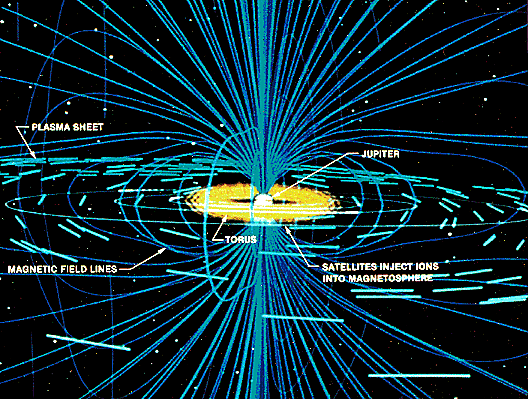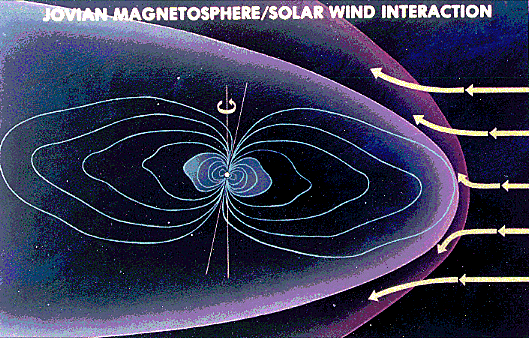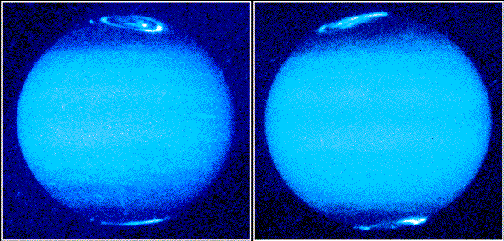 |
| Jupiter's magnetic field (Ref) |
Jupiter has a large, complex, and intense magnetic field that is thought to arise from electrical currents in the rapidly spinning metallic hydrogen interior. The Earth has a strong magnetic field, but Jupiter's magnetic field at the tops of its clouds is 10 times stronger than that of the Earth. Further, the Jovian magnetic field has much higher complexity than that of the Earth, with some aspects of Jupiter's fields having no Earthly counterpart. The intensity and complexity relative to the magnetic field of the Earth is presumably related in some way to the more rapid rotation and larger metallic interior for Jupiter.
 |
| Jupiter's magnetic field (Ref) |
The field is doughnut shaped (toroidal), containing giant versions of the Earth's Van Allen Belts that trap high-energy charged particles (mostly electrons and protons). Because of the forces associated with the rapid rotation of Jupiter and its magnetic field, these "belts" are flattened into "plasma sheets" in the case of Jupiter. The field rotates with the approximately 9 hour rotational period of the planet. The satellites Amalthea, Io, Europa, and Ganymede all orbit through this region; they are affected by it and in turn affect the magnetic field and charged-particle belts, as we discuss further below. For example, the surface of Io is being eroded by collisions with these particles as it moves about its orbit.
The plasma torus indicated in the preceding figure is associated with the orbit of Io. As we will see, Io has multiple active volcanoes on its surface. These spew a gas of particles into space that become ionized as Io moves about its orbit, and these particles eventually diffuse into the rest of the region surrounding Jupiter. As we discuss further below, this is a major source of the charged particles trapped in the Jovian magnetic field. Thus, Io is both responsible for many of the charged particles in Jupiter's magnetic field, and is being eroded by collisions with those particles as it orbits Jupiter.
 |
| Jupiter's magnetosphere and interaction with the solar wind (Ref) |
The magnetosphere is strongly affected by the solar wind, pulsing in shape and size. It can shrink to 1/3 of its maximum size when the solar wind is strong.
 |
| Auroras on Jupiter imaged by HST ( Explanation) |
On Earth, many of the charged particles trapped in our magnetic field originate in the solar wind. Since the bow shock of Jupiter's magnetosphere deflects the solar wind well away from Jupiter's atmosphere, the charged particles responsible for Jupiter's auroras must come from another source. They are thought to originate from the innermost satellites like Io that orbit in the region of strong magnetic field and trapped charged particles.